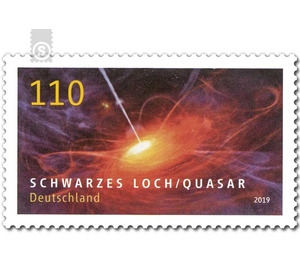Series "Astrophysics" - Black Hole / Quasar - Germany / Federal Republic of Germany 2019 - 110 Euro Cent
Theme: Astronomy & Space
| Country | Germany / Federal Republic of Germany |
| Issue Date | 2019 |
| Face Value | 110.00 |
| Color | orange red violet |
| Printing Type | Multicolor offset printing |
| Stamp Type | Commemorative |
| Item Type | Stamp |
| SID | 560153 |
| Dimensions | 44.00 x 26.00 |
| In 37 Wishlists | |
The brightest celestial bodies that have been discovered so far are quasars. Observers can only perceive the radiation sources, several billion light years away from Earth and originating from the earliest time in the universe, as points of light. Quasars are not stars, but active centers of galaxies, from which we absorb significant radiation in the area of radio waves. Therefore, they have their name: it means something like "quasi-stellar radio sources", so star-like objects. For a long time nobody knew the place of origin of the huge amounts of energy emitted by the quasars. Astrophysicists believe that they come from supermassive black holes in their centers. Because quasars absorb enormous amounts of matter and release energy in the form of radiation, they possess this high luminosity. According to recent studies, there are black holes in the middle of each galaxy, but the quasars are up to a thousand times more massive than those in the center of our Milky Way galaxy. It was surprising for the physicists that such giants apparently already existed less than a billion years after the big bang. So you have to grow very fast. There is still some confusion about how and why such massive black holes could form. Quasars were discovered in the late 1950s in sky surveys at radio wavelengths. But the only punctiform "stars" were far too bright for their immense distance. In 1963, the Dutch physicist Maarten Schmidt recognized by spectral analysis that the object 3C 273 could not be an ordinary star. The evidence for the existence of quasars finally provided the Hubble Space Telescope: It photographed in 1996 for the first time their host galaxies. The brightest known quasar is SMSS J2157-3602. At its center is a black hole with 20 billion solar masses, which devours matter every two days with the mass of our sun.


